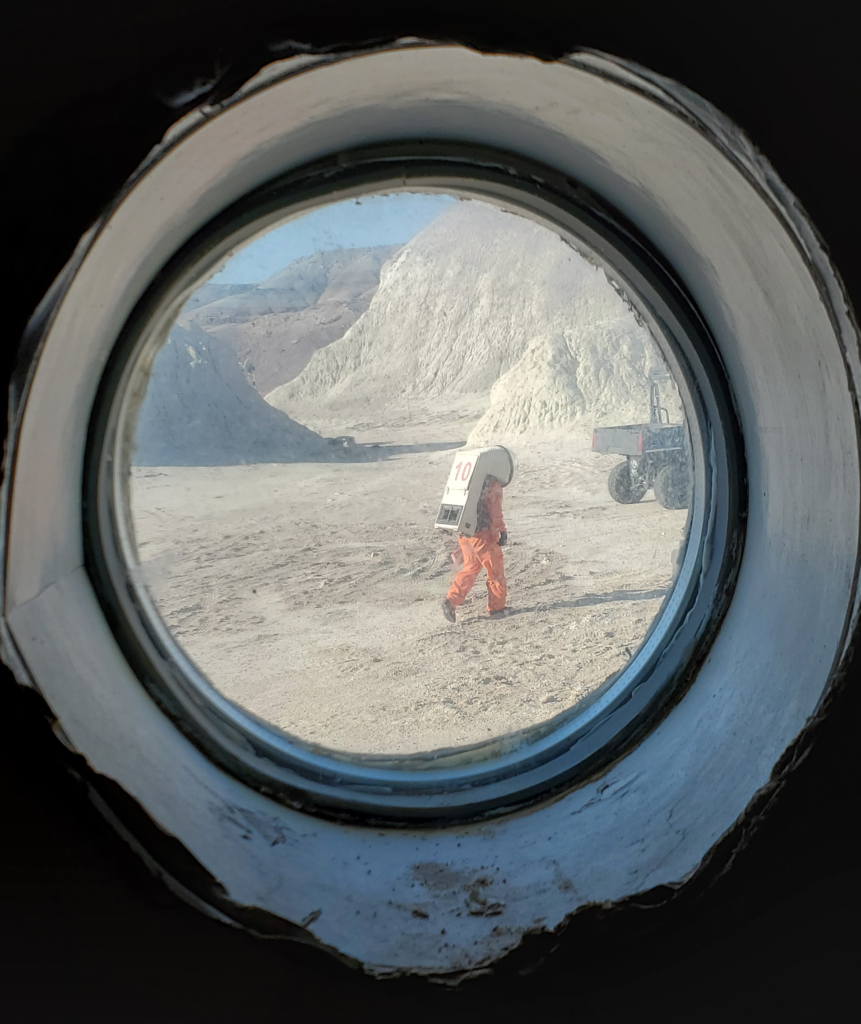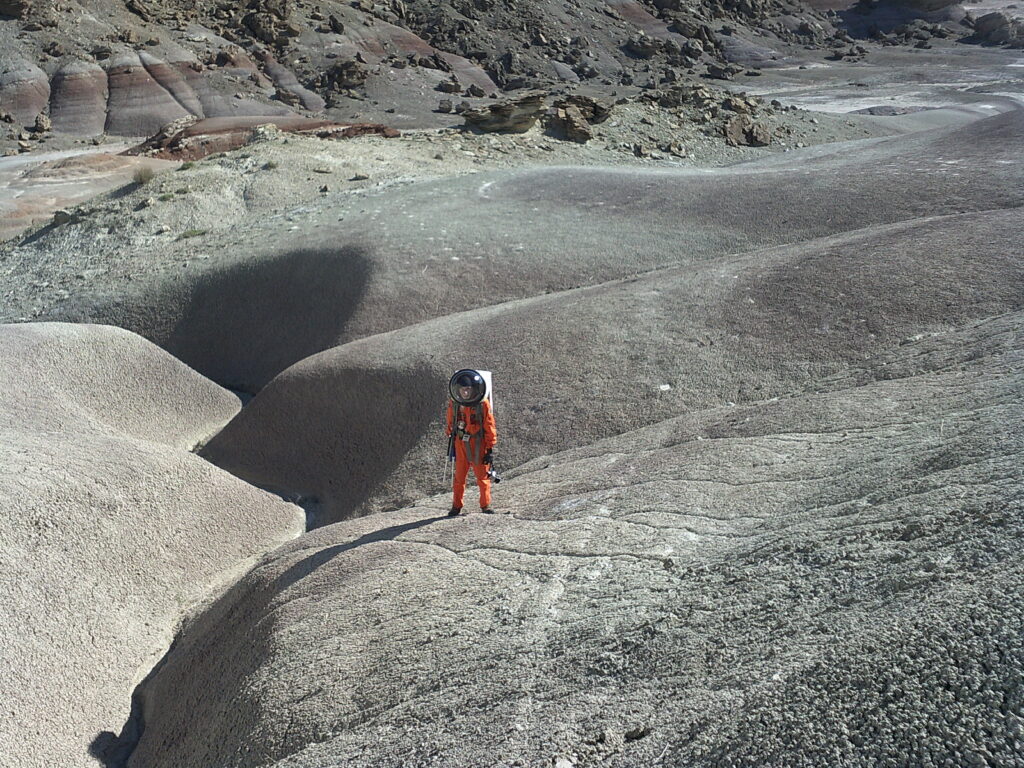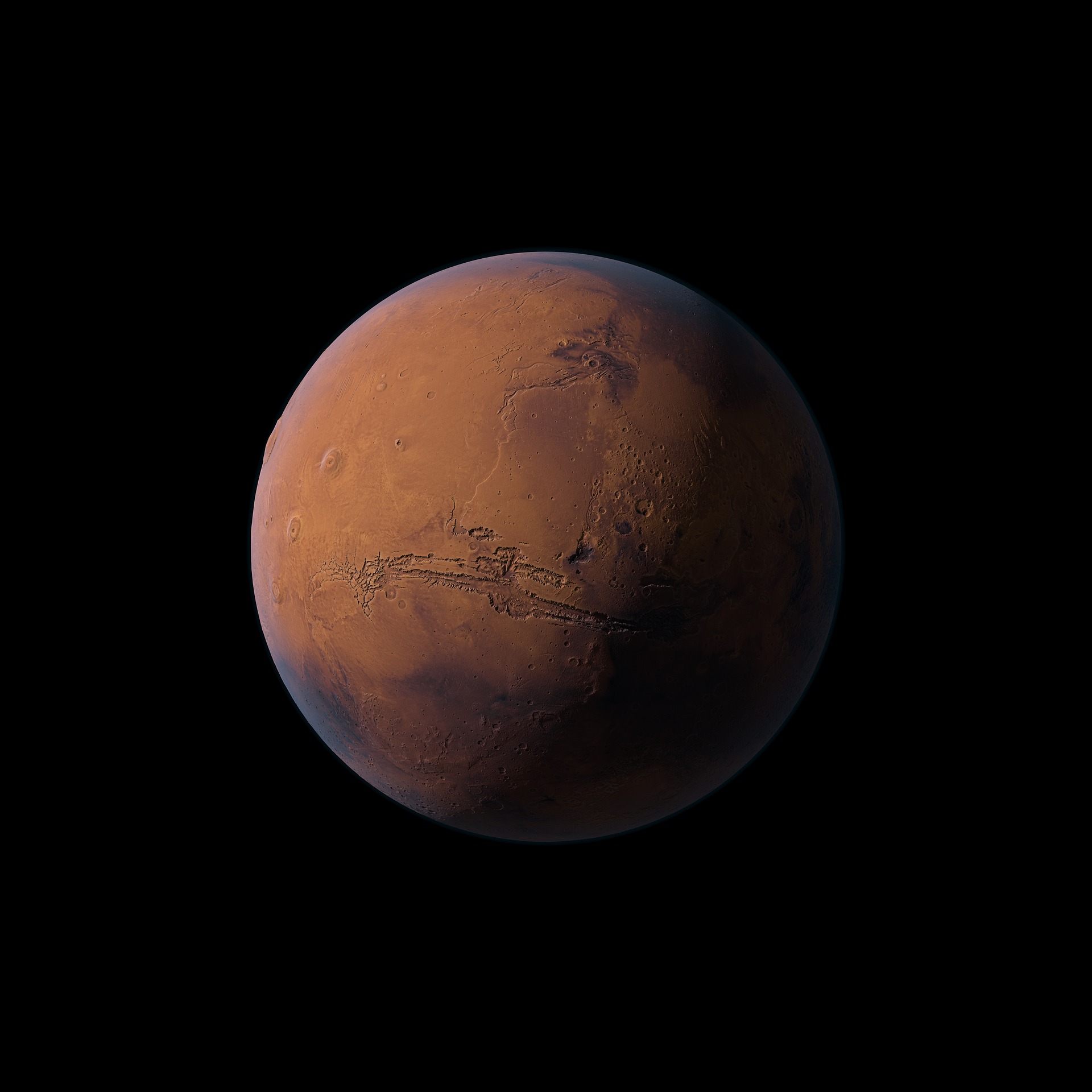Welcome back to Diaries from Analog Mars. If this is your first visit, consider reading the previous entries here. In part eight, Jin and his crew navigate the treacherous Martian landscape, and set out on a critical re-supply mission.
Diaries From Analog Mars Menu
“The best-laid plans of mice and men; gang aft agley.”
from “to a mouse” by Robert Burns
On Sol 5, Inga and Dave would face their own trials out in the field.
The protocol at the MDRS is that requests for EVAs are submitted the night before, by 8:30 PM. On the evening of Sol 4 after my EVA with Lindsay, I sat at the table with Dave and Inga to help plan their EVA. Before the simulation had begun, Dr. Rupert had given us an overview of the MDRS’s surrounding geography – features such as Cow Dung Road, peaks and ridges, the escarpments, and the dried-up riverbed, where the swathes of Moonlike terrain were located. She recommended that we visit what appeared to be a dried-up river delta that flowed out of the ancient river south of the Hab, as that was underexplored.
The riverbed itself runs North-South and snakes through a plateau about thirty to forty metres high. At its center lie dark river sediments. Using the elevation data I had in my digital map, I ran a calculation of the slope. I found that the escarpment connecting the plateau to the lower plain on which the Hab sits has slopes of well over twenty degrees. Based on aerial imagery, those slopes look like they are uneven and composed of crumbly material – this would already be challenging for hikers to ascend, and is mostly impassable in a bulky EVA suit.
From the delta itself extends Kissing Camel Ridge, going east and curving to the north. The ridge is pierced by Cow Dung Road; travelers entering or leaving the MDRS area through the ridge drive through a narrow pass flanked by boulder-strewn hills called Robert’s Rock Garden. I like to call driving through the pass ‘threading the eye of the needle’.
As we panned through the map, Dave and I found a small pass where the computer had calculated a relatively gentle slope of ten to fifteen degrees. The pass could potentially be a valuable access point to scale the escarpment and explore the delta. I wished I had thermal inertia data for the region as well, which would give me an idea of how rocky it was – this is how mission planners estimate the rockiness of candidate landing sites on Mars. Together, Dave and Inga decided that they would ‘thread the needle’ and park just south of Robert’s Rock Garden, then hike west with Kissing Camel Ridge on their right until they encountered the escarpment. They would then try to find the pass with GPS and ascend it.
However, exploring the local geology was far from their only objective. As with all activities we conducted at the MDRS, Inga would take notes on how we interacted as a group and the whole team would be collecting pictures and video for outreach (which I’ve been borrowing to post on these blogs for y’all.) I would also be comparing their experiences to what I saw on the map, providing us with EVA planning experience as a crew. Dave would test the usefulness of adding a sunshade to the EVA helmets (i.e. he would drape an old t-shirt on top of it and see how well it blocked out the Sun.)
The most important objective of all, though, was retrieving life-giving granola from Dave’s RV- I mean personal supply ship. In the Handbook’s food inventory, granola was listed as a food that would be available at the MDRS, and Dave was deeply excited to enjoy it once here. However, for one reason or another, it hadn’t been stocked for our rotation. For the past four sols, Dave had been musing about and scheming ways to obtain the all-important granola. He had brought some with him in his supply ship, but expecting to find granola in the Hab, he did not take it with him before the simulation started. Now that we were ‘in-sim’, we could not just step outside to grab it – we had to request an EVA. Dave justified the EVA as being a test of the suits’ ability to unload supply drops from confined spaces. Dave and Inga would extract the granola on their way back from the delta.
Just after 9 AM, Dave and Inga entered the airlock. At my suggestion, they took the rovers Curiosity and Perseverance. With some adjustments to her suit harness, Inga now had better visibility of the rover’s control panel. They turned right onto Cow Dung Road and drove south. I wished them a good EVA over the radio and sat down in front of my laptop, intending to check in again once they had arrived at Robert’s Rock Garden.

What I had forgotten to account for though, was that the structure at Robert’s Rock Garden created a radio blackout pocket right at the ‘eye of the needle’. After an hour, I had still heard nothing from them and was beginning to get worried. I discussed potentially breaking sim to go after them with Lindsay, but Dr. Rupert reminded us that the south side of Kissing Camel Ridge was a known radio blackout area and that they were likely fine. I realized that the issue had not been with the radio communications per se, but with our protocols about radio check-ins. Lindsay went to the Science Dome to begin setting up her genomics project while I stayed in the Hab upper deck, hailing the EVA team every fifteen minutes.
About a couple of hours after the EVA had begun, I heard the crackle of static on the radio.
“HabComm to EVA team, comm check, over.”
Inga’s voice penetrated the dense forest of static.
“EVA team…we are…location…six eight degrees north…”
“EVA team, this is HabComm. I didn’t quite get that. Please say again.”
More static.
“HabComm to EVA team, comm check, over.”
No response.
I didn’t catch their location, but it seemed that they were okay. Later, I heard Dave’s voice and scrambled up the ladder into the Hab’s loft to get better reception. Although communications were patchy and difficult to understand, I was able to obtain their status.
At around 12 PM, they must have emerged from behind the Kissing Camel ridges, because their voices were suddenly clear and static-free. Unfortunately, some visitors had stopped near the campus near where Dave’s supply ship was parked, and so Dr. Rupert recommended not stopping to pick up the granola because getting close to the visitors would break sim. However, Dave must have remotely willed them out of the way because I was soon informing him that the visitors had dispersed, and that he was once again clear to retrieve the “all-important granola, vital for the existence of intelligent life”, to quote him.
I heard them rummaging around in the supply ship for the granola box, then saw them parking the rovers, unloading the spice melange- I mean granola, and returning to the airlock triumphantly.

I later learned that the pass they had wanted to climb – that we thought had a nice, gentle slope – was too uneven to ascend safely in EVA suits. It had a staircase-like structure, composed of many small steps 1-2 metres tall. So while the elevation map I had on hand showed that the area had a low average slope, the map’s pixel size was too large to show the true unevenness of the area.

They investigated a few other potential entry points to the delta but were unsuccessful in finding one that would be easy to scale in EVA suits. It sounded like Mars was throwing us another challenge, and I was determined to find a safe way onto that delta. I scoured the digital map and the pictures Dave and Inga had taken, but it seemed that the only surefire way to know would be to visit the escarpment myself.
The lessons learned from Dave and Inga’s EVA helped me strengthen my independence in investigating my own interests at MDRS. My practical experience in geography and EVA operations had advanced by leaps and bounds – although perhaps just enough to be dangerous. Perhaps I could learn more practical lessons in the sols ahead with more ambitious projects. For example, I recommended that the HabComm person be stationed on the Hab’s upper deck most of the time, because that had the best radio reception. I also recommended that EVA teams check in with HabComm on arrival at their target site to keep them apprised. I became interested in not just predicting regions of radio blackout, but also testing how accurate the predictions were in the field. It seemed that my questions were multiplying faster than my answers. I had not been interested in geography before – it seemed that it took going to Mars to get me into it.
While it was the landscape, the station, the suits, and the procedures that made me feel like I was on Mars, it was discovering a strong sense of ownership and direction for my geography project that made me feel like an astronaut – like I was doing truly useful research here that could benefit those who come after me. I wonder if geography is something I should study professionally in preparation for when it’s time to board the rocket for real Mars.
I also learned that knowledge can be found everywhere, even in the smallest of things – like in retrieving granola. Inga joked that all the trouble they had gone through to extract the granola should be made into an ad. She told me to picture two astronauts that have gone all the way to Mars to obtain the lifesaving granola: “Would you do THAT for your breakfast?”


Be a part of this!
The Mars Society of Canada offers a professional and credible platform for all space advocates to promote Canada’s participation in Mars science and exploration. By becoming a member of our federal not-for-profit, you provide direct support for our educational, public outreach and analog research efforts. We proudly represent the voice of thousands of Canadians who believe in the profound benefit of Mars exploration, and a multi-planetary future for humanity.
Edited by Evan Plant-Weir
